Leadership in Nursing: Theories, Impact on Nurses & Patients
VerifiedAdded on 2022/01/06
|13
|3834
|35
Essay
AI Summary
This essay delves into the critical role of leadership and management within the nursing profession, emphasizing its significance in patient care and healthcare system operations. It provides an overview of various leadership theories, including autocratic, democratic, Laissez-faire, participative, authoritative, transformational, and situational leadership, highlighting their diverse approaches and applications. The essay then focuses on a literature review of transformational leadership, examining its four key aspects: individualized consideration, inspirational motivation, intellectual stimulation, and idealized influence. It explores how transformational leadership affects the nurse's role, decision-making processes, and interactions with patients, and how it contributes to improved patient satisfaction and healthcare outcomes. The essay also discusses potential drawbacks of transformational leadership, such as the risk of employee burnout and the pressure to achieve goals, emphasizing the importance of ethical considerations and balancing performance with the well-being of nurses and patients. The paper concludes by analyzing the impact of leadership and management on nursing practices, healthcare policies, and overall system efficiency.
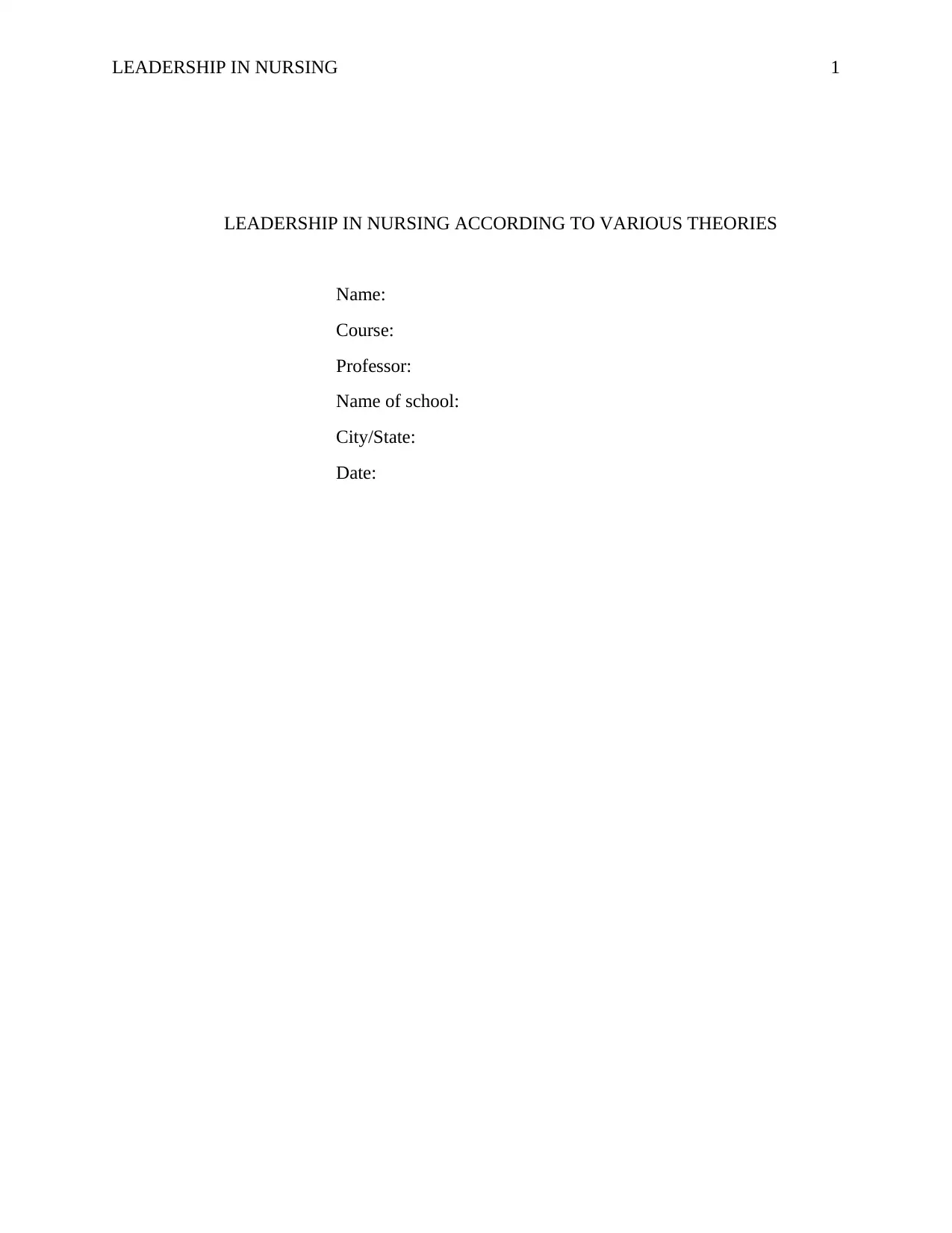
LEADERSHIP IN NURSING 1
LEADERSHIP IN NURSING ACCORDING TO VARIOUS THEORIES
Name:
Course:
Professor:
Name of school:
City/State:
Date:
LEADERSHIP IN NURSING ACCORDING TO VARIOUS THEORIES
Name:
Course:
Professor:
Name of school:
City/State:
Date:
Paraphrase This Document
Need a fresh take? Get an instant paraphrase of this document with our AI Paraphraser
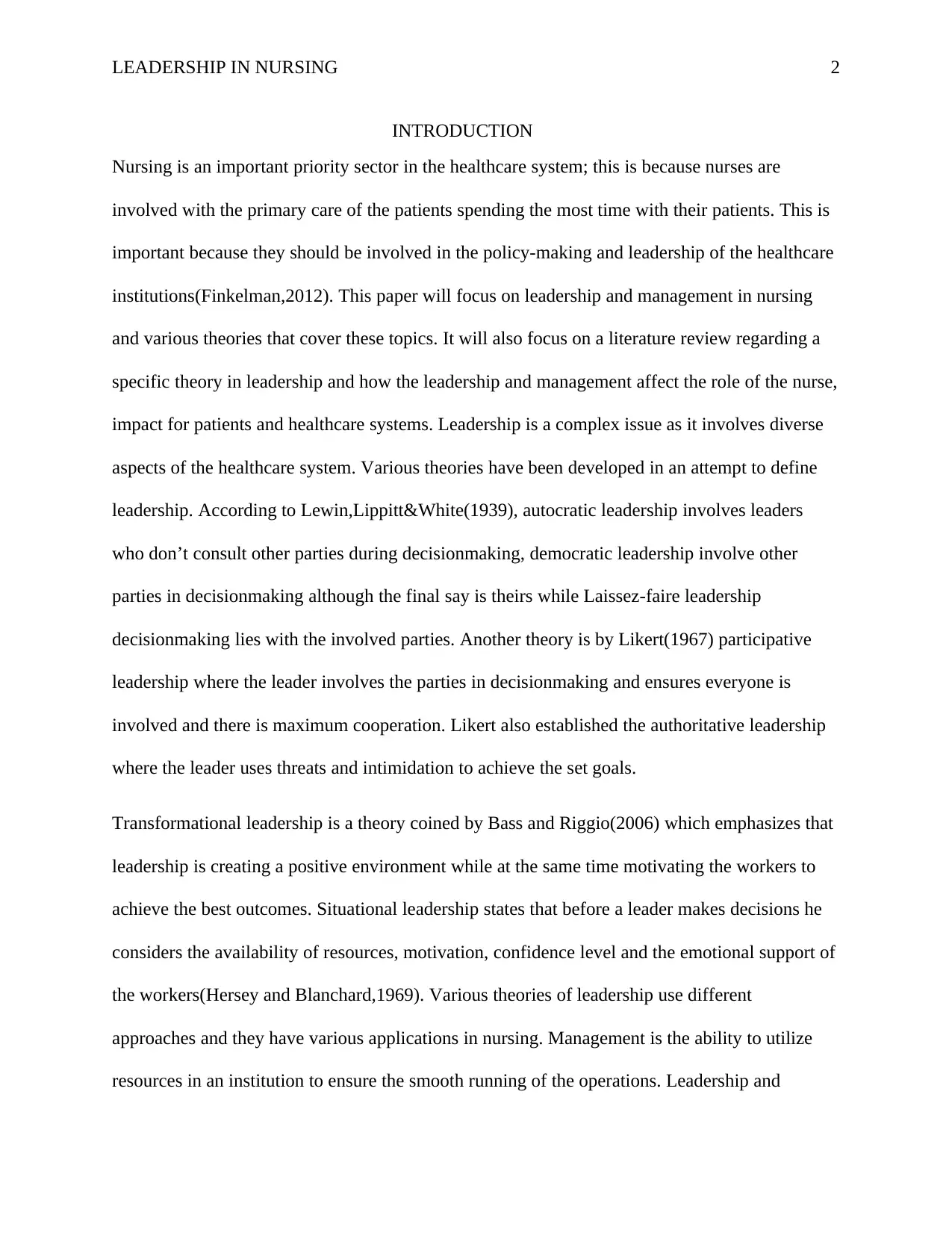
LEADERSHIP IN NURSING 2
INTRODUCTION
Nursing is an important priority sector in the healthcare system; this is because nurses are
involved with the primary care of the patients spending the most time with their patients. This is
important because they should be involved in the policy-making and leadership of the healthcare
institutions(Finkelman,2012). This paper will focus on leadership and management in nursing
and various theories that cover these topics. It will also focus on a literature review regarding a
specific theory in leadership and how the leadership and management affect the role of the nurse,
impact for patients and healthcare systems. Leadership is a complex issue as it involves diverse
aspects of the healthcare system. Various theories have been developed in an attempt to define
leadership. According to Lewin,Lippitt&White(1939), autocratic leadership involves leaders
who don’t consult other parties during decisionmaking, democratic leadership involve other
parties in decisionmaking although the final say is theirs while Laissez-faire leadership
decisionmaking lies with the involved parties. Another theory is by Likert(1967) participative
leadership where the leader involves the parties in decisionmaking and ensures everyone is
involved and there is maximum cooperation. Likert also established the authoritative leadership
where the leader uses threats and intimidation to achieve the set goals.
Transformational leadership is a theory coined by Bass and Riggio(2006) which emphasizes that
leadership is creating a positive environment while at the same time motivating the workers to
achieve the best outcomes. Situational leadership states that before a leader makes decisions he
considers the availability of resources, motivation, confidence level and the emotional support of
the workers(Hersey and Blanchard,1969). Various theories of leadership use different
approaches and they have various applications in nursing. Management is the ability to utilize
resources in an institution to ensure the smooth running of the operations. Leadership and
INTRODUCTION
Nursing is an important priority sector in the healthcare system; this is because nurses are
involved with the primary care of the patients spending the most time with their patients. This is
important because they should be involved in the policy-making and leadership of the healthcare
institutions(Finkelman,2012). This paper will focus on leadership and management in nursing
and various theories that cover these topics. It will also focus on a literature review regarding a
specific theory in leadership and how the leadership and management affect the role of the nurse,
impact for patients and healthcare systems. Leadership is a complex issue as it involves diverse
aspects of the healthcare system. Various theories have been developed in an attempt to define
leadership. According to Lewin,Lippitt&White(1939), autocratic leadership involves leaders
who don’t consult other parties during decisionmaking, democratic leadership involve other
parties in decisionmaking although the final say is theirs while Laissez-faire leadership
decisionmaking lies with the involved parties. Another theory is by Likert(1967) participative
leadership where the leader involves the parties in decisionmaking and ensures everyone is
involved and there is maximum cooperation. Likert also established the authoritative leadership
where the leader uses threats and intimidation to achieve the set goals.
Transformational leadership is a theory coined by Bass and Riggio(2006) which emphasizes that
leadership is creating a positive environment while at the same time motivating the workers to
achieve the best outcomes. Situational leadership states that before a leader makes decisions he
considers the availability of resources, motivation, confidence level and the emotional support of
the workers(Hersey and Blanchard,1969). Various theories of leadership use different
approaches and they have various applications in nursing. Management is the ability to utilize
resources in an institution to ensure the smooth running of the operations. Leadership and
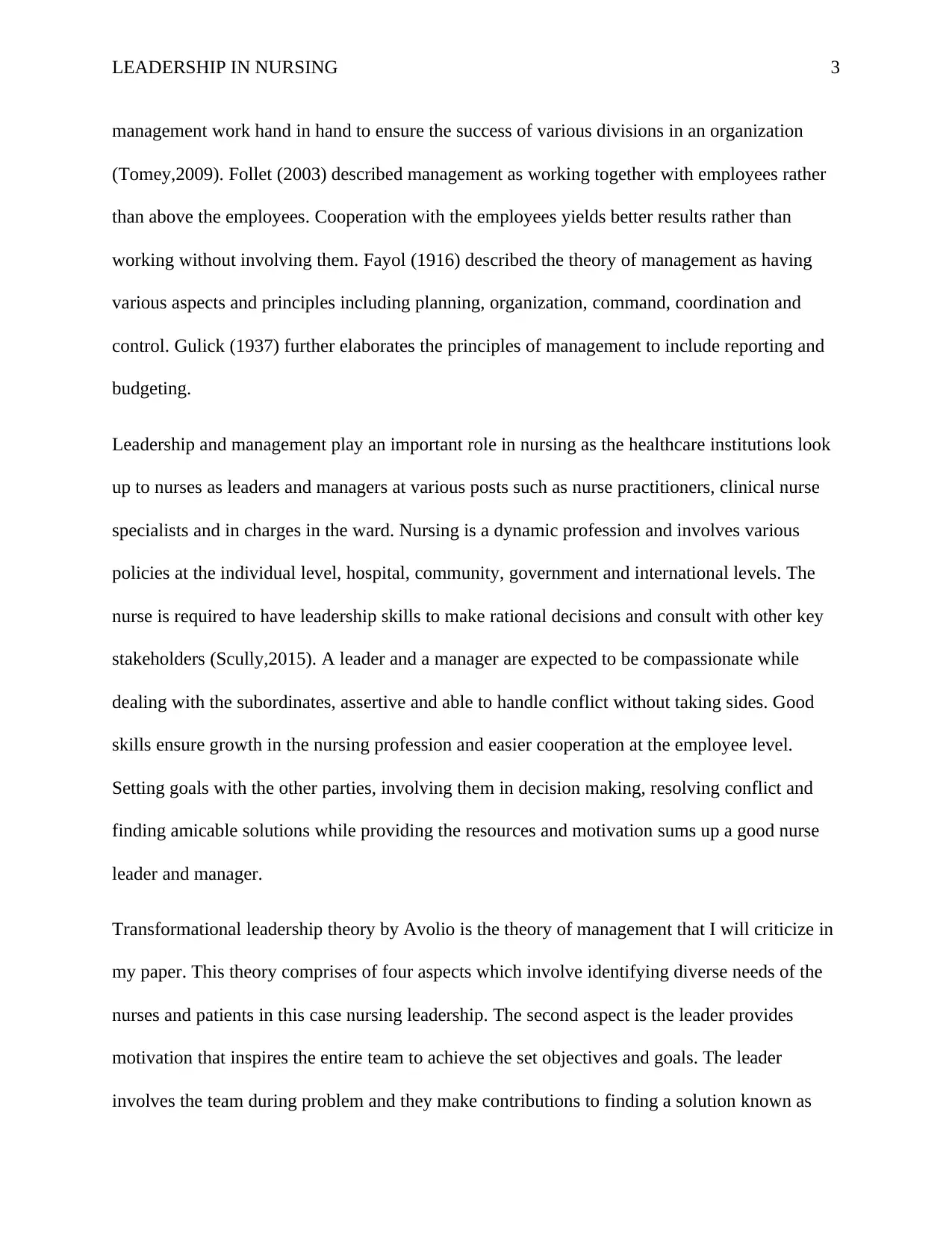
LEADERSHIP IN NURSING 3
management work hand in hand to ensure the success of various divisions in an organization
(Tomey,2009). Follet (2003) described management as working together with employees rather
than above the employees. Cooperation with the employees yields better results rather than
working without involving them. Fayol (1916) described the theory of management as having
various aspects and principles including planning, organization, command, coordination and
control. Gulick (1937) further elaborates the principles of management to include reporting and
budgeting.
Leadership and management play an important role in nursing as the healthcare institutions look
up to nurses as leaders and managers at various posts such as nurse practitioners, clinical nurse
specialists and in charges in the ward. Nursing is a dynamic profession and involves various
policies at the individual level, hospital, community, government and international levels. The
nurse is required to have leadership skills to make rational decisions and consult with other key
stakeholders (Scully,2015). A leader and a manager are expected to be compassionate while
dealing with the subordinates, assertive and able to handle conflict without taking sides. Good
skills ensure growth in the nursing profession and easier cooperation at the employee level.
Setting goals with the other parties, involving them in decision making, resolving conflict and
finding amicable solutions while providing the resources and motivation sums up a good nurse
leader and manager.
Transformational leadership theory by Avolio is the theory of management that I will criticize in
my paper. This theory comprises of four aspects which involve identifying diverse needs of the
nurses and patients in this case nursing leadership. The second aspect is the leader provides
motivation that inspires the entire team to achieve the set objectives and goals. The leader
involves the team during problem and they make contributions to finding a solution known as
management work hand in hand to ensure the success of various divisions in an organization
(Tomey,2009). Follet (2003) described management as working together with employees rather
than above the employees. Cooperation with the employees yields better results rather than
working without involving them. Fayol (1916) described the theory of management as having
various aspects and principles including planning, organization, command, coordination and
control. Gulick (1937) further elaborates the principles of management to include reporting and
budgeting.
Leadership and management play an important role in nursing as the healthcare institutions look
up to nurses as leaders and managers at various posts such as nurse practitioners, clinical nurse
specialists and in charges in the ward. Nursing is a dynamic profession and involves various
policies at the individual level, hospital, community, government and international levels. The
nurse is required to have leadership skills to make rational decisions and consult with other key
stakeholders (Scully,2015). A leader and a manager are expected to be compassionate while
dealing with the subordinates, assertive and able to handle conflict without taking sides. Good
skills ensure growth in the nursing profession and easier cooperation at the employee level.
Setting goals with the other parties, involving them in decision making, resolving conflict and
finding amicable solutions while providing the resources and motivation sums up a good nurse
leader and manager.
Transformational leadership theory by Avolio is the theory of management that I will criticize in
my paper. This theory comprises of four aspects which involve identifying diverse needs of the
nurses and patients in this case nursing leadership. The second aspect is the leader provides
motivation that inspires the entire team to achieve the set objectives and goals. The leader
involves the team during problem and they make contributions to finding a solution known as
⊘ This is a preview!⊘
Do you want full access?
Subscribe today to unlock all pages.

Trusted by 1+ million students worldwide
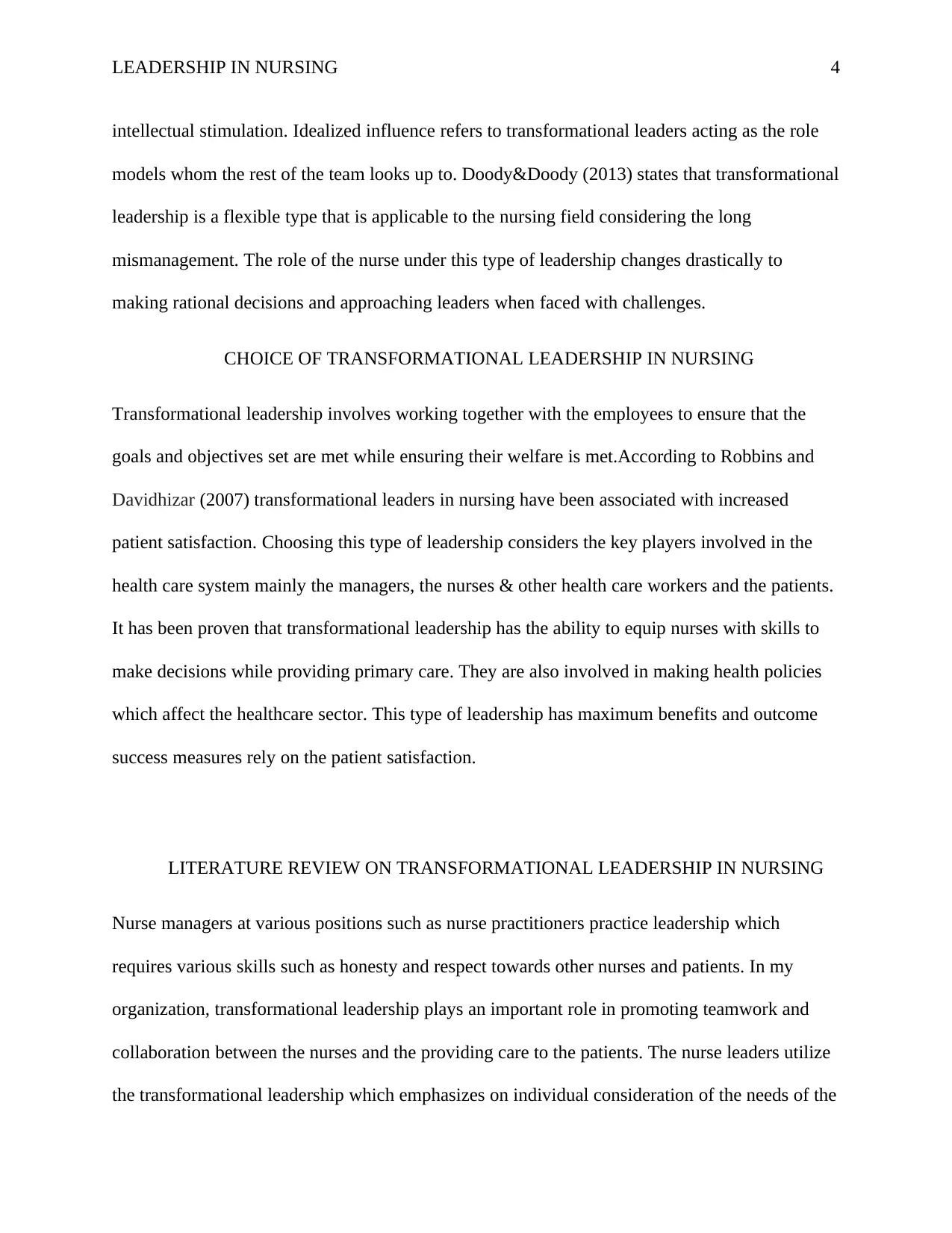
LEADERSHIP IN NURSING 4
intellectual stimulation. Idealized influence refers to transformational leaders acting as the role
models whom the rest of the team looks up to. Doody&Doody (2013) states that transformational
leadership is a flexible type that is applicable to the nursing field considering the long
mismanagement. The role of the nurse under this type of leadership changes drastically to
making rational decisions and approaching leaders when faced with challenges.
CHOICE OF TRANSFORMATIONAL LEADERSHIP IN NURSING
Transformational leadership involves working together with the employees to ensure that the
goals and objectives set are met while ensuring their welfare is met.According to Robbins and
Davidhizar (2007) transformational leaders in nursing have been associated with increased
patient satisfaction. Choosing this type of leadership considers the key players involved in the
health care system mainly the managers, the nurses & other health care workers and the patients.
It has been proven that transformational leadership has the ability to equip nurses with skills to
make decisions while providing primary care. They are also involved in making health policies
which affect the healthcare sector. This type of leadership has maximum benefits and outcome
success measures rely on the patient satisfaction.
LITERATURE REVIEW ON TRANSFORMATIONAL LEADERSHIP IN NURSING
Nurse managers at various positions such as nurse practitioners practice leadership which
requires various skills such as honesty and respect towards other nurses and patients. In my
organization, transformational leadership plays an important role in promoting teamwork and
collaboration between the nurses and the providing care to the patients. The nurse leaders utilize
the transformational leadership which emphasizes on individual consideration of the needs of the
intellectual stimulation. Idealized influence refers to transformational leaders acting as the role
models whom the rest of the team looks up to. Doody&Doody (2013) states that transformational
leadership is a flexible type that is applicable to the nursing field considering the long
mismanagement. The role of the nurse under this type of leadership changes drastically to
making rational decisions and approaching leaders when faced with challenges.
CHOICE OF TRANSFORMATIONAL LEADERSHIP IN NURSING
Transformational leadership involves working together with the employees to ensure that the
goals and objectives set are met while ensuring their welfare is met.According to Robbins and
Davidhizar (2007) transformational leaders in nursing have been associated with increased
patient satisfaction. Choosing this type of leadership considers the key players involved in the
health care system mainly the managers, the nurses & other health care workers and the patients.
It has been proven that transformational leadership has the ability to equip nurses with skills to
make decisions while providing primary care. They are also involved in making health policies
which affect the healthcare sector. This type of leadership has maximum benefits and outcome
success measures rely on the patient satisfaction.
LITERATURE REVIEW ON TRANSFORMATIONAL LEADERSHIP IN NURSING
Nurse managers at various positions such as nurse practitioners practice leadership which
requires various skills such as honesty and respect towards other nurses and patients. In my
organization, transformational leadership plays an important role in promoting teamwork and
collaboration between the nurses and the providing care to the patients. The nurse leaders utilize
the transformational leadership which emphasizes on individual consideration of the needs of the
Paraphrase This Document
Need a fresh take? Get an instant paraphrase of this document with our AI Paraphraser
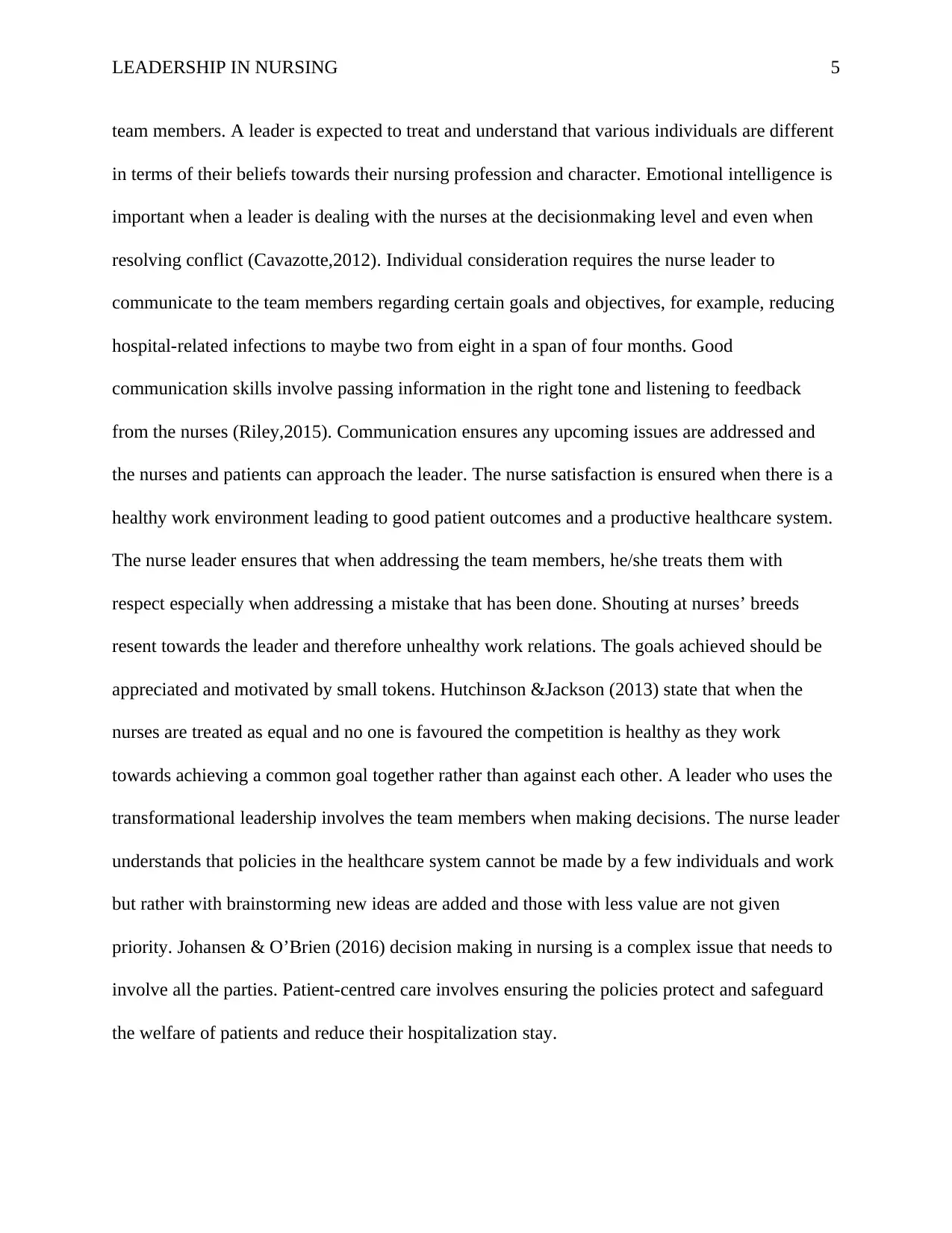
LEADERSHIP IN NURSING 5
team members. A leader is expected to treat and understand that various individuals are different
in terms of their beliefs towards their nursing profession and character. Emotional intelligence is
important when a leader is dealing with the nurses at the decisionmaking level and even when
resolving conflict (Cavazotte,2012). Individual consideration requires the nurse leader to
communicate to the team members regarding certain goals and objectives, for example, reducing
hospital-related infections to maybe two from eight in a span of four months. Good
communication skills involve passing information in the right tone and listening to feedback
from the nurses (Riley,2015). Communication ensures any upcoming issues are addressed and
the nurses and patients can approach the leader. The nurse satisfaction is ensured when there is a
healthy work environment leading to good patient outcomes and a productive healthcare system.
The nurse leader ensures that when addressing the team members, he/she treats them with
respect especially when addressing a mistake that has been done. Shouting at nurses’ breeds
resent towards the leader and therefore unhealthy work relations. The goals achieved should be
appreciated and motivated by small tokens. Hutchinson &Jackson (2013) state that when the
nurses are treated as equal and no one is favoured the competition is healthy as they work
towards achieving a common goal together rather than against each other. A leader who uses the
transformational leadership involves the team members when making decisions. The nurse leader
understands that policies in the healthcare system cannot be made by a few individuals and work
but rather with brainstorming new ideas are added and those with less value are not given
priority. Johansen & O’Brien (2016) decision making in nursing is a complex issue that needs to
involve all the parties. Patient-centred care involves ensuring the policies protect and safeguard
the welfare of patients and reduce their hospitalization stay.
team members. A leader is expected to treat and understand that various individuals are different
in terms of their beliefs towards their nursing profession and character. Emotional intelligence is
important when a leader is dealing with the nurses at the decisionmaking level and even when
resolving conflict (Cavazotte,2012). Individual consideration requires the nurse leader to
communicate to the team members regarding certain goals and objectives, for example, reducing
hospital-related infections to maybe two from eight in a span of four months. Good
communication skills involve passing information in the right tone and listening to feedback
from the nurses (Riley,2015). Communication ensures any upcoming issues are addressed and
the nurses and patients can approach the leader. The nurse satisfaction is ensured when there is a
healthy work environment leading to good patient outcomes and a productive healthcare system.
The nurse leader ensures that when addressing the team members, he/she treats them with
respect especially when addressing a mistake that has been done. Shouting at nurses’ breeds
resent towards the leader and therefore unhealthy work relations. The goals achieved should be
appreciated and motivated by small tokens. Hutchinson &Jackson (2013) state that when the
nurses are treated as equal and no one is favoured the competition is healthy as they work
towards achieving a common goal together rather than against each other. A leader who uses the
transformational leadership involves the team members when making decisions. The nurse leader
understands that policies in the healthcare system cannot be made by a few individuals and work
but rather with brainstorming new ideas are added and those with less value are not given
priority. Johansen & O’Brien (2016) decision making in nursing is a complex issue that needs to
involve all the parties. Patient-centred care involves ensuring the policies protect and safeguard
the welfare of patients and reduce their hospitalization stay.
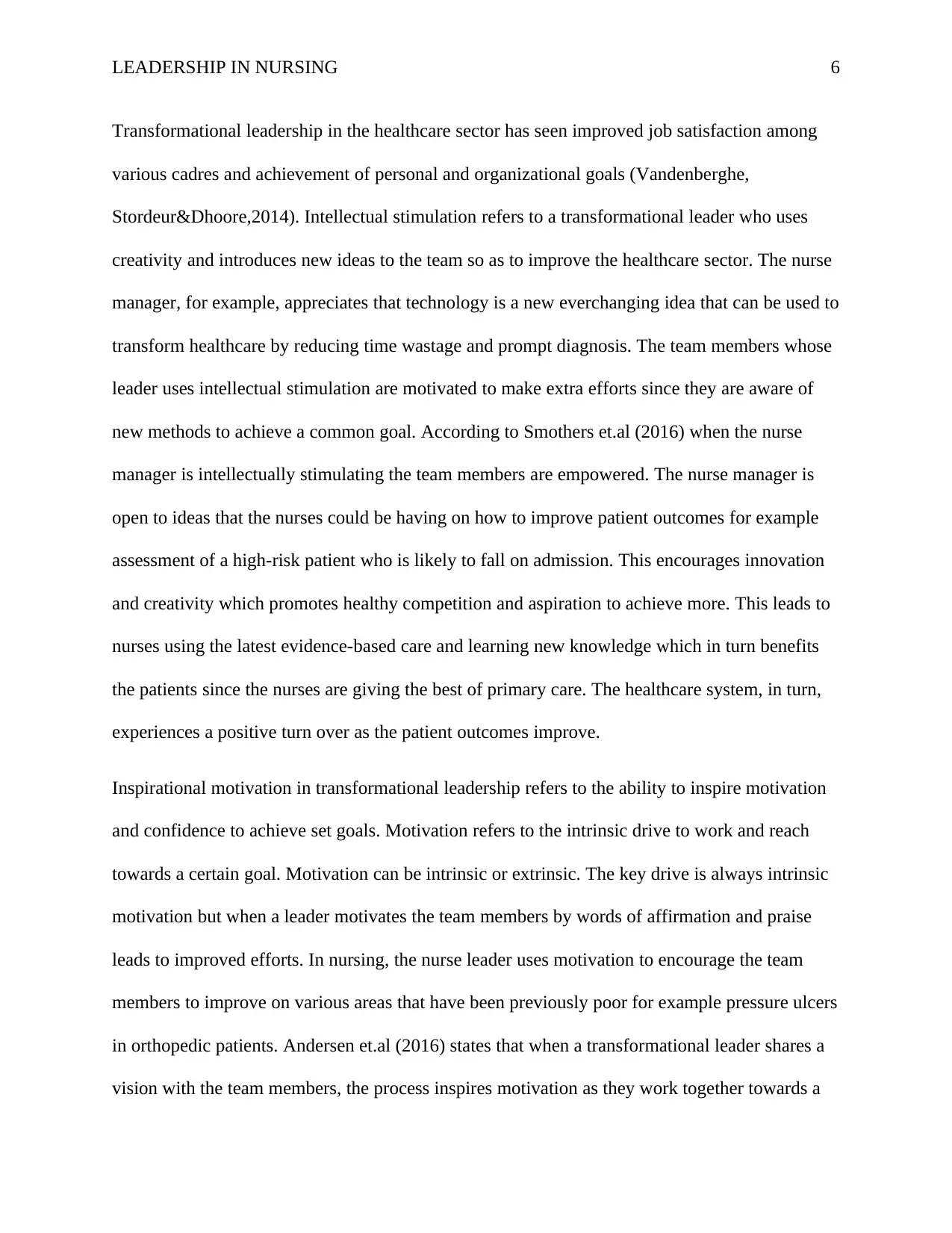
LEADERSHIP IN NURSING 6
Transformational leadership in the healthcare sector has seen improved job satisfaction among
various cadres and achievement of personal and organizational goals (Vandenberghe,
Stordeur&Dhoore,2014). Intellectual stimulation refers to a transformational leader who uses
creativity and introduces new ideas to the team so as to improve the healthcare sector. The nurse
manager, for example, appreciates that technology is a new everchanging idea that can be used to
transform healthcare by reducing time wastage and prompt diagnosis. The team members whose
leader uses intellectual stimulation are motivated to make extra efforts since they are aware of
new methods to achieve a common goal. According to Smothers et.al (2016) when the nurse
manager is intellectually stimulating the team members are empowered. The nurse manager is
open to ideas that the nurses could be having on how to improve patient outcomes for example
assessment of a high-risk patient who is likely to fall on admission. This encourages innovation
and creativity which promotes healthy competition and aspiration to achieve more. This leads to
nurses using the latest evidence-based care and learning new knowledge which in turn benefits
the patients since the nurses are giving the best of primary care. The healthcare system, in turn,
experiences a positive turn over as the patient outcomes improve.
Inspirational motivation in transformational leadership refers to the ability to inspire motivation
and confidence to achieve set goals. Motivation refers to the intrinsic drive to work and reach
towards a certain goal. Motivation can be intrinsic or extrinsic. The key drive is always intrinsic
motivation but when a leader motivates the team members by words of affirmation and praise
leads to improved efforts. In nursing, the nurse leader uses motivation to encourage the team
members to improve on various areas that have been previously poor for example pressure ulcers
in orthopedic patients. Andersen et.al (2016) states that when a transformational leader shares a
vision with the team members, the process inspires motivation as they work together towards a
Transformational leadership in the healthcare sector has seen improved job satisfaction among
various cadres and achievement of personal and organizational goals (Vandenberghe,
Stordeur&Dhoore,2014). Intellectual stimulation refers to a transformational leader who uses
creativity and introduces new ideas to the team so as to improve the healthcare sector. The nurse
manager, for example, appreciates that technology is a new everchanging idea that can be used to
transform healthcare by reducing time wastage and prompt diagnosis. The team members whose
leader uses intellectual stimulation are motivated to make extra efforts since they are aware of
new methods to achieve a common goal. According to Smothers et.al (2016) when the nurse
manager is intellectually stimulating the team members are empowered. The nurse manager is
open to ideas that the nurses could be having on how to improve patient outcomes for example
assessment of a high-risk patient who is likely to fall on admission. This encourages innovation
and creativity which promotes healthy competition and aspiration to achieve more. This leads to
nurses using the latest evidence-based care and learning new knowledge which in turn benefits
the patients since the nurses are giving the best of primary care. The healthcare system, in turn,
experiences a positive turn over as the patient outcomes improve.
Inspirational motivation in transformational leadership refers to the ability to inspire motivation
and confidence to achieve set goals. Motivation refers to the intrinsic drive to work and reach
towards a certain goal. Motivation can be intrinsic or extrinsic. The key drive is always intrinsic
motivation but when a leader motivates the team members by words of affirmation and praise
leads to improved efforts. In nursing, the nurse leader uses motivation to encourage the team
members to improve on various areas that have been previously poor for example pressure ulcers
in orthopedic patients. Andersen et.al (2016) states that when a transformational leader shares a
vision with the team members, the process inspires motivation as they work together towards a
⊘ This is a preview!⊘
Do you want full access?
Subscribe today to unlock all pages.

Trusted by 1+ million students worldwide
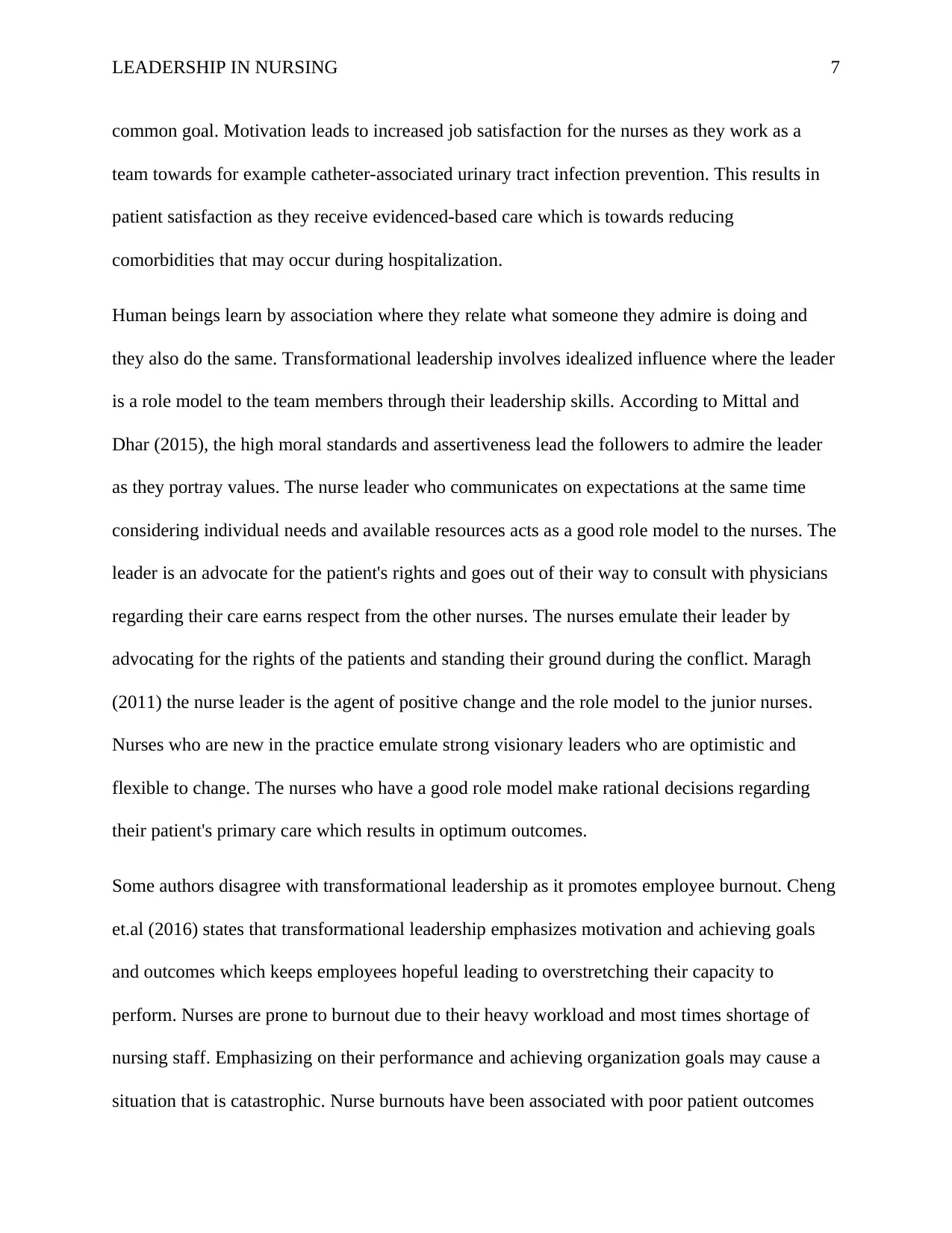
LEADERSHIP IN NURSING 7
common goal. Motivation leads to increased job satisfaction for the nurses as they work as a
team towards for example catheter-associated urinary tract infection prevention. This results in
patient satisfaction as they receive evidenced-based care which is towards reducing
comorbidities that may occur during hospitalization.
Human beings learn by association where they relate what someone they admire is doing and
they also do the same. Transformational leadership involves idealized influence where the leader
is a role model to the team members through their leadership skills. According to Mittal and
Dhar (2015), the high moral standards and assertiveness lead the followers to admire the leader
as they portray values. The nurse leader who communicates on expectations at the same time
considering individual needs and available resources acts as a good role model to the nurses. The
leader is an advocate for the patient's rights and goes out of their way to consult with physicians
regarding their care earns respect from the other nurses. The nurses emulate their leader by
advocating for the rights of the patients and standing their ground during the conflict. Maragh
(2011) the nurse leader is the agent of positive change and the role model to the junior nurses.
Nurses who are new in the practice emulate strong visionary leaders who are optimistic and
flexible to change. The nurses who have a good role model make rational decisions regarding
their patient's primary care which results in optimum outcomes.
Some authors disagree with transformational leadership as it promotes employee burnout. Cheng
et.al (2016) states that transformational leadership emphasizes motivation and achieving goals
and outcomes which keeps employees hopeful leading to overstretching their capacity to
perform. Nurses are prone to burnout due to their heavy workload and most times shortage of
nursing staff. Emphasizing on their performance and achieving organization goals may cause a
situation that is catastrophic. Nurse burnouts have been associated with poor patient outcomes
common goal. Motivation leads to increased job satisfaction for the nurses as they work as a
team towards for example catheter-associated urinary tract infection prevention. This results in
patient satisfaction as they receive evidenced-based care which is towards reducing
comorbidities that may occur during hospitalization.
Human beings learn by association where they relate what someone they admire is doing and
they also do the same. Transformational leadership involves idealized influence where the leader
is a role model to the team members through their leadership skills. According to Mittal and
Dhar (2015), the high moral standards and assertiveness lead the followers to admire the leader
as they portray values. The nurse leader who communicates on expectations at the same time
considering individual needs and available resources acts as a good role model to the nurses. The
leader is an advocate for the patient's rights and goes out of their way to consult with physicians
regarding their care earns respect from the other nurses. The nurses emulate their leader by
advocating for the rights of the patients and standing their ground during the conflict. Maragh
(2011) the nurse leader is the agent of positive change and the role model to the junior nurses.
Nurses who are new in the practice emulate strong visionary leaders who are optimistic and
flexible to change. The nurses who have a good role model make rational decisions regarding
their patient's primary care which results in optimum outcomes.
Some authors disagree with transformational leadership as it promotes employee burnout. Cheng
et.al (2016) states that transformational leadership emphasizes motivation and achieving goals
and outcomes which keeps employees hopeful leading to overstretching their capacity to
perform. Nurses are prone to burnout due to their heavy workload and most times shortage of
nursing staff. Emphasizing on their performance and achieving organization goals may cause a
situation that is catastrophic. Nurse burnouts have been associated with poor patient outcomes
Paraphrase This Document
Need a fresh take? Get an instant paraphrase of this document with our AI Paraphraser
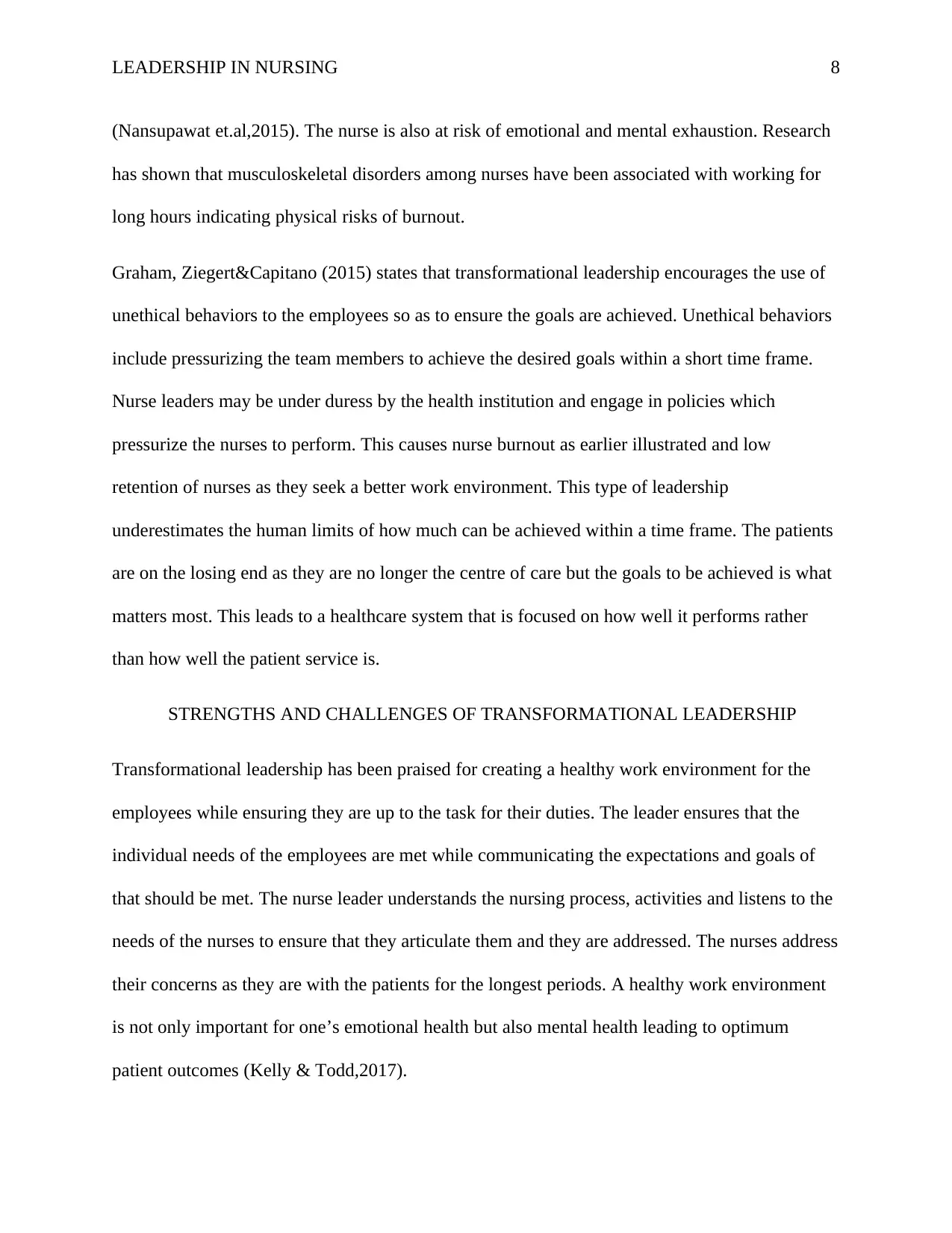
LEADERSHIP IN NURSING 8
(Nansupawat et.al,2015). The nurse is also at risk of emotional and mental exhaustion. Research
has shown that musculoskeletal disorders among nurses have been associated with working for
long hours indicating physical risks of burnout.
Graham, Ziegert&Capitano (2015) states that transformational leadership encourages the use of
unethical behaviors to the employees so as to ensure the goals are achieved. Unethical behaviors
include pressurizing the team members to achieve the desired goals within a short time frame.
Nurse leaders may be under duress by the health institution and engage in policies which
pressurize the nurses to perform. This causes nurse burnout as earlier illustrated and low
retention of nurses as they seek a better work environment. This type of leadership
underestimates the human limits of how much can be achieved within a time frame. The patients
are on the losing end as they are no longer the centre of care but the goals to be achieved is what
matters most. This leads to a healthcare system that is focused on how well it performs rather
than how well the patient service is.
STRENGTHS AND CHALLENGES OF TRANSFORMATIONAL LEADERSHIP
Transformational leadership has been praised for creating a healthy work environment for the
employees while ensuring they are up to the task for their duties. The leader ensures that the
individual needs of the employees are met while communicating the expectations and goals of
that should be met. The nurse leader understands the nursing process, activities and listens to the
needs of the nurses to ensure that they articulate them and they are addressed. The nurses address
their concerns as they are with the patients for the longest periods. A healthy work environment
is not only important for one’s emotional health but also mental health leading to optimum
patient outcomes (Kelly & Todd,2017).
(Nansupawat et.al,2015). The nurse is also at risk of emotional and mental exhaustion. Research
has shown that musculoskeletal disorders among nurses have been associated with working for
long hours indicating physical risks of burnout.
Graham, Ziegert&Capitano (2015) states that transformational leadership encourages the use of
unethical behaviors to the employees so as to ensure the goals are achieved. Unethical behaviors
include pressurizing the team members to achieve the desired goals within a short time frame.
Nurse leaders may be under duress by the health institution and engage in policies which
pressurize the nurses to perform. This causes nurse burnout as earlier illustrated and low
retention of nurses as they seek a better work environment. This type of leadership
underestimates the human limits of how much can be achieved within a time frame. The patients
are on the losing end as they are no longer the centre of care but the goals to be achieved is what
matters most. This leads to a healthcare system that is focused on how well it performs rather
than how well the patient service is.
STRENGTHS AND CHALLENGES OF TRANSFORMATIONAL LEADERSHIP
Transformational leadership has been praised for creating a healthy work environment for the
employees while ensuring they are up to the task for their duties. The leader ensures that the
individual needs of the employees are met while communicating the expectations and goals of
that should be met. The nurse leader understands the nursing process, activities and listens to the
needs of the nurses to ensure that they articulate them and they are addressed. The nurses address
their concerns as they are with the patients for the longest periods. A healthy work environment
is not only important for one’s emotional health but also mental health leading to optimum
patient outcomes (Kelly & Todd,2017).
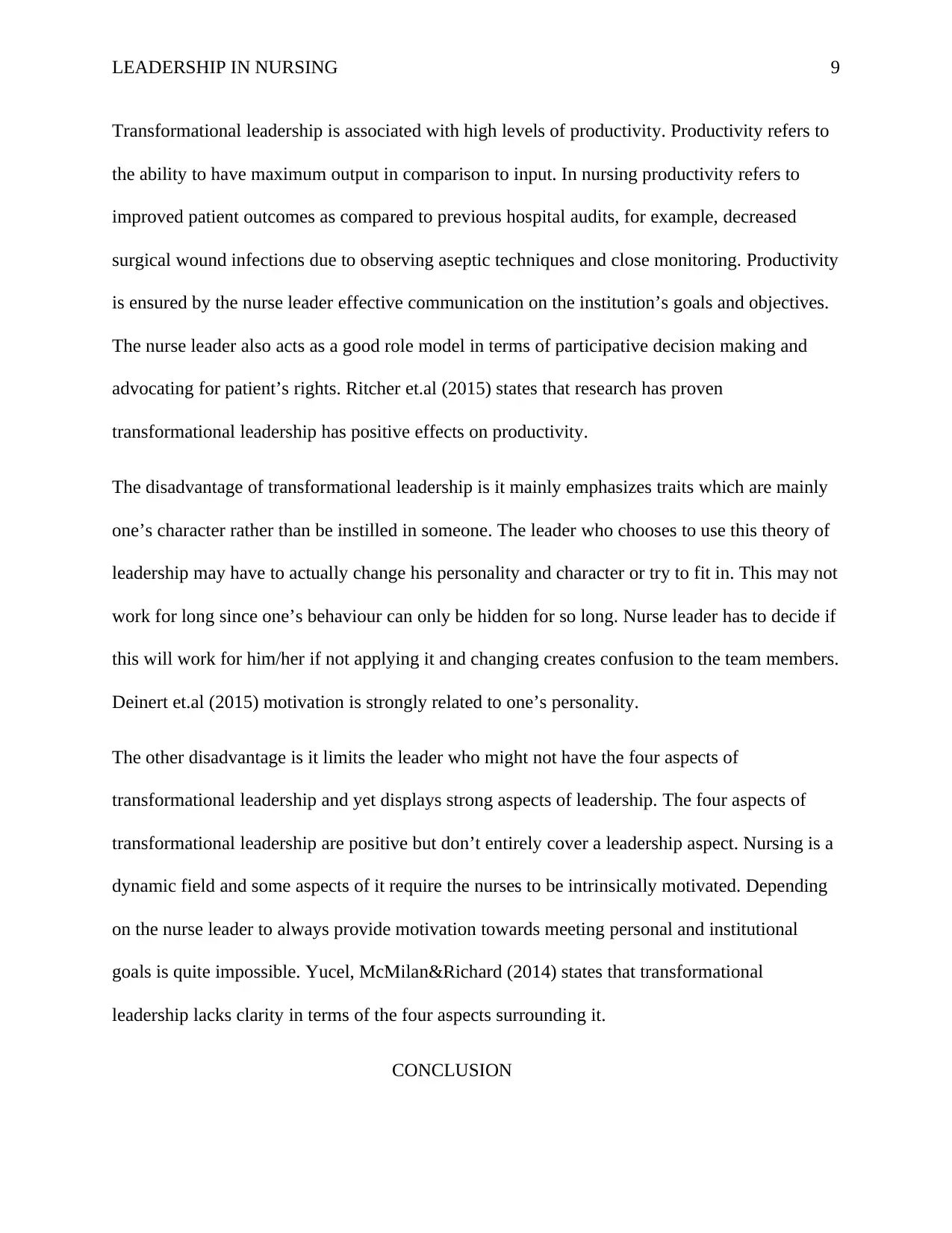
LEADERSHIP IN NURSING 9
Transformational leadership is associated with high levels of productivity. Productivity refers to
the ability to have maximum output in comparison to input. In nursing productivity refers to
improved patient outcomes as compared to previous hospital audits, for example, decreased
surgical wound infections due to observing aseptic techniques and close monitoring. Productivity
is ensured by the nurse leader effective communication on the institution’s goals and objectives.
The nurse leader also acts as a good role model in terms of participative decision making and
advocating for patient’s rights. Ritcher et.al (2015) states that research has proven
transformational leadership has positive effects on productivity.
The disadvantage of transformational leadership is it mainly emphasizes traits which are mainly
one’s character rather than be instilled in someone. The leader who chooses to use this theory of
leadership may have to actually change his personality and character or try to fit in. This may not
work for long since one’s behaviour can only be hidden for so long. Nurse leader has to decide if
this will work for him/her if not applying it and changing creates confusion to the team members.
Deinert et.al (2015) motivation is strongly related to one’s personality.
The other disadvantage is it limits the leader who might not have the four aspects of
transformational leadership and yet displays strong aspects of leadership. The four aspects of
transformational leadership are positive but don’t entirely cover a leadership aspect. Nursing is a
dynamic field and some aspects of it require the nurses to be intrinsically motivated. Depending
on the nurse leader to always provide motivation towards meeting personal and institutional
goals is quite impossible. Yucel, McMilan&Richard (2014) states that transformational
leadership lacks clarity in terms of the four aspects surrounding it.
CONCLUSION
Transformational leadership is associated with high levels of productivity. Productivity refers to
the ability to have maximum output in comparison to input. In nursing productivity refers to
improved patient outcomes as compared to previous hospital audits, for example, decreased
surgical wound infections due to observing aseptic techniques and close monitoring. Productivity
is ensured by the nurse leader effective communication on the institution’s goals and objectives.
The nurse leader also acts as a good role model in terms of participative decision making and
advocating for patient’s rights. Ritcher et.al (2015) states that research has proven
transformational leadership has positive effects on productivity.
The disadvantage of transformational leadership is it mainly emphasizes traits which are mainly
one’s character rather than be instilled in someone. The leader who chooses to use this theory of
leadership may have to actually change his personality and character or try to fit in. This may not
work for long since one’s behaviour can only be hidden for so long. Nurse leader has to decide if
this will work for him/her if not applying it and changing creates confusion to the team members.
Deinert et.al (2015) motivation is strongly related to one’s personality.
The other disadvantage is it limits the leader who might not have the four aspects of
transformational leadership and yet displays strong aspects of leadership. The four aspects of
transformational leadership are positive but don’t entirely cover a leadership aspect. Nursing is a
dynamic field and some aspects of it require the nurses to be intrinsically motivated. Depending
on the nurse leader to always provide motivation towards meeting personal and institutional
goals is quite impossible. Yucel, McMilan&Richard (2014) states that transformational
leadership lacks clarity in terms of the four aspects surrounding it.
CONCLUSION
⊘ This is a preview!⊘
Do you want full access?
Subscribe today to unlock all pages.

Trusted by 1+ million students worldwide
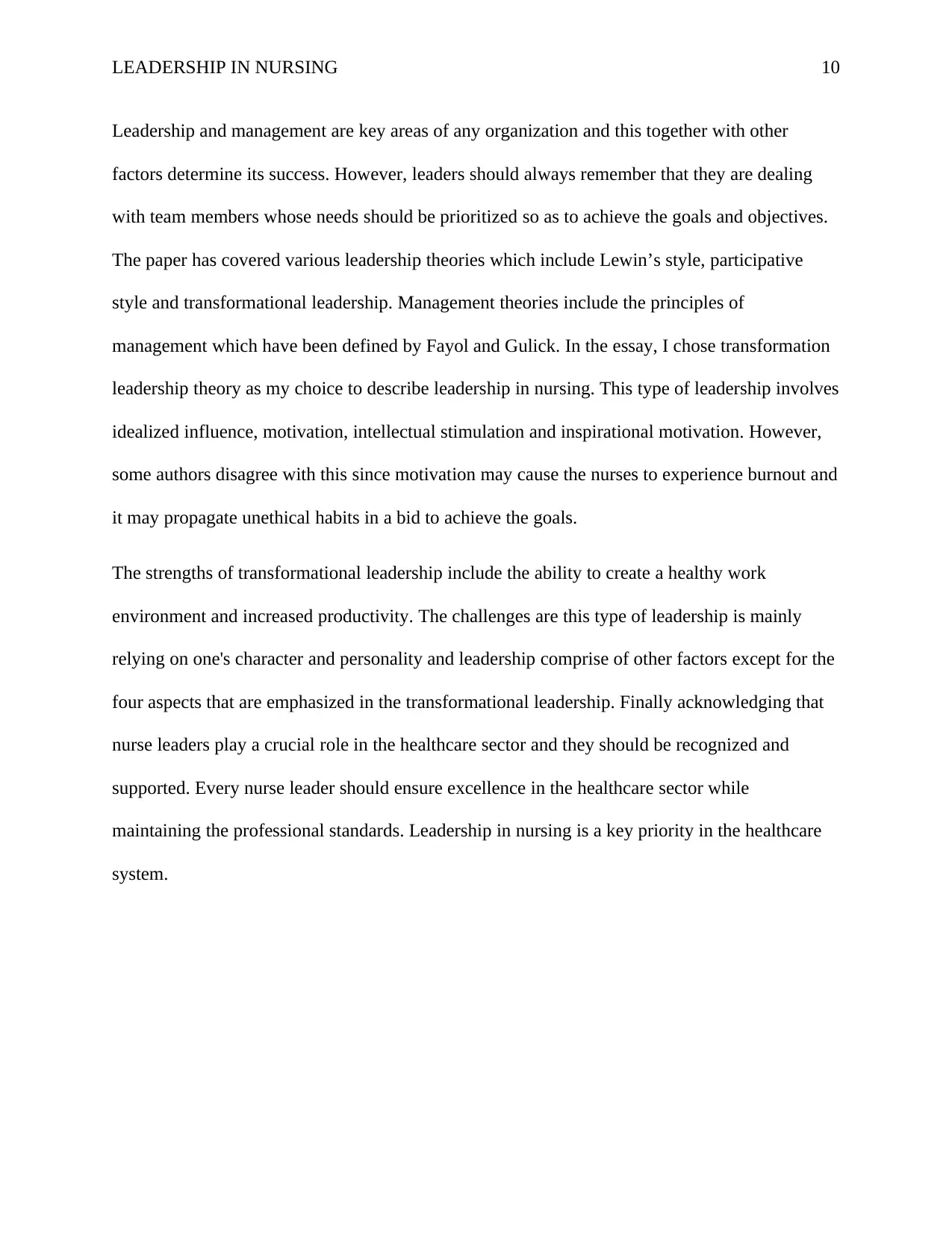
LEADERSHIP IN NURSING 10
Leadership and management are key areas of any organization and this together with other
factors determine its success. However, leaders should always remember that they are dealing
with team members whose needs should be prioritized so as to achieve the goals and objectives.
The paper has covered various leadership theories which include Lewin’s style, participative
style and transformational leadership. Management theories include the principles of
management which have been defined by Fayol and Gulick. In the essay, I chose transformation
leadership theory as my choice to describe leadership in nursing. This type of leadership involves
idealized influence, motivation, intellectual stimulation and inspirational motivation. However,
some authors disagree with this since motivation may cause the nurses to experience burnout and
it may propagate unethical habits in a bid to achieve the goals.
The strengths of transformational leadership include the ability to create a healthy work
environment and increased productivity. The challenges are this type of leadership is mainly
relying on one's character and personality and leadership comprise of other factors except for the
four aspects that are emphasized in the transformational leadership. Finally acknowledging that
nurse leaders play a crucial role in the healthcare sector and they should be recognized and
supported. Every nurse leader should ensure excellence in the healthcare sector while
maintaining the professional standards. Leadership in nursing is a key priority in the healthcare
system.
Leadership and management are key areas of any organization and this together with other
factors determine its success. However, leaders should always remember that they are dealing
with team members whose needs should be prioritized so as to achieve the goals and objectives.
The paper has covered various leadership theories which include Lewin’s style, participative
style and transformational leadership. Management theories include the principles of
management which have been defined by Fayol and Gulick. In the essay, I chose transformation
leadership theory as my choice to describe leadership in nursing. This type of leadership involves
idealized influence, motivation, intellectual stimulation and inspirational motivation. However,
some authors disagree with this since motivation may cause the nurses to experience burnout and
it may propagate unethical habits in a bid to achieve the goals.
The strengths of transformational leadership include the ability to create a healthy work
environment and increased productivity. The challenges are this type of leadership is mainly
relying on one's character and personality and leadership comprise of other factors except for the
four aspects that are emphasized in the transformational leadership. Finally acknowledging that
nurse leaders play a crucial role in the healthcare sector and they should be recognized and
supported. Every nurse leader should ensure excellence in the healthcare sector while
maintaining the professional standards. Leadership in nursing is a key priority in the healthcare
system.
Paraphrase This Document
Need a fresh take? Get an instant paraphrase of this document with our AI Paraphraser
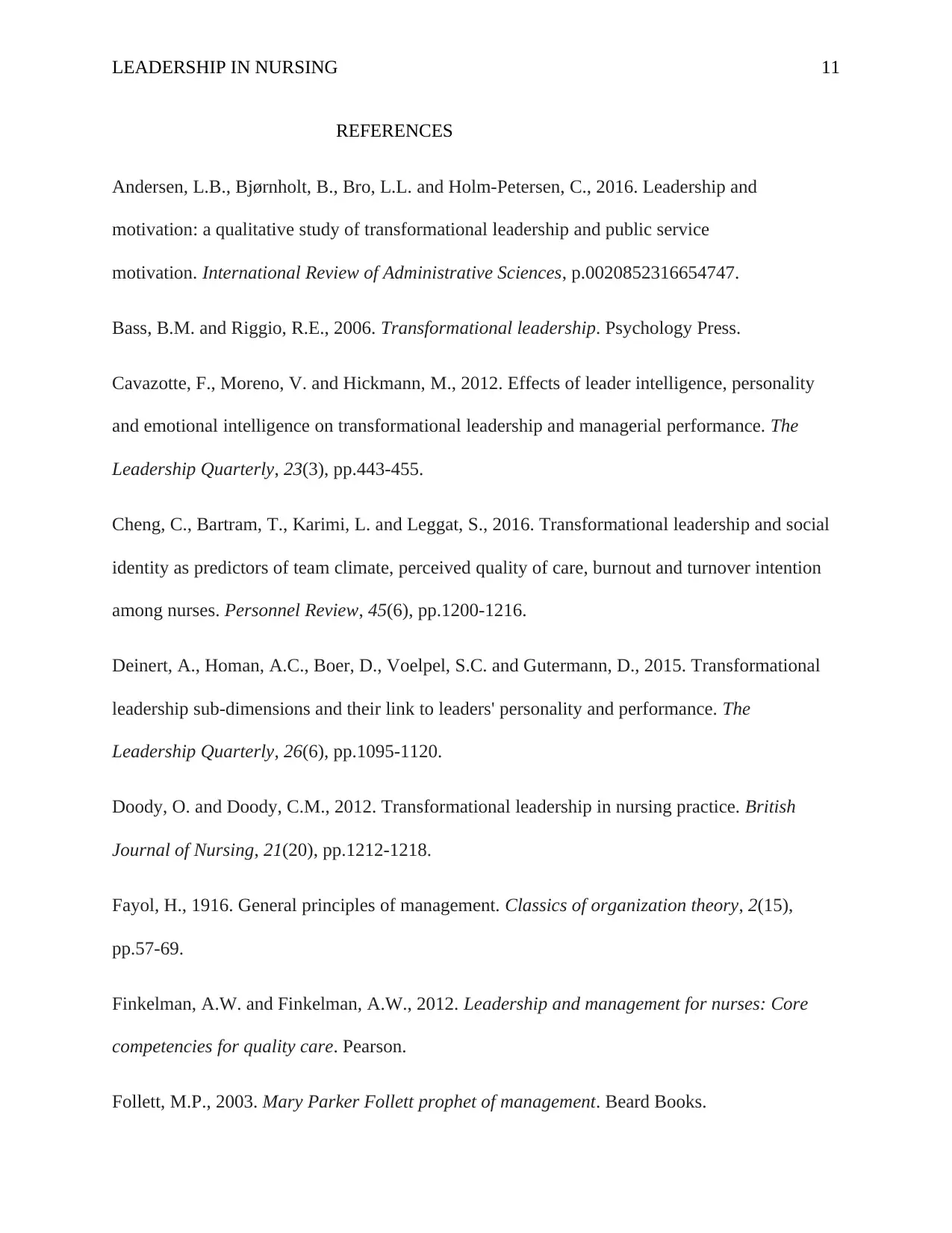
LEADERSHIP IN NURSING 11
REFERENCES
Andersen, L.B., Bjørnholt, B., Bro, L.L. and Holm-Petersen, C., 2016. Leadership and
motivation: a qualitative study of transformational leadership and public service
motivation. International Review of Administrative Sciences, p.0020852316654747.
Bass, B.M. and Riggio, R.E., 2006. Transformational leadership. Psychology Press.
Cavazotte, F., Moreno, V. and Hickmann, M., 2012. Effects of leader intelligence, personality
and emotional intelligence on transformational leadership and managerial performance. The
Leadership Quarterly, 23(3), pp.443-455.
Cheng, C., Bartram, T., Karimi, L. and Leggat, S., 2016. Transformational leadership and social
identity as predictors of team climate, perceived quality of care, burnout and turnover intention
among nurses. Personnel Review, 45(6), pp.1200-1216.
Deinert, A., Homan, A.C., Boer, D., Voelpel, S.C. and Gutermann, D., 2015. Transformational
leadership sub-dimensions and their link to leaders' personality and performance. The
Leadership Quarterly, 26(6), pp.1095-1120.
Doody, O. and Doody, C.M., 2012. Transformational leadership in nursing practice. British
Journal of Nursing, 21(20), pp.1212-1218.
Fayol, H., 1916. General principles of management. Classics of organization theory, 2(15),
pp.57-69.
Finkelman, A.W. and Finkelman, A.W., 2012. Leadership and management for nurses: Core
competencies for quality care. Pearson.
Follett, M.P., 2003. Mary Parker Follett prophet of management. Beard Books.
REFERENCES
Andersen, L.B., Bjørnholt, B., Bro, L.L. and Holm-Petersen, C., 2016. Leadership and
motivation: a qualitative study of transformational leadership and public service
motivation. International Review of Administrative Sciences, p.0020852316654747.
Bass, B.M. and Riggio, R.E., 2006. Transformational leadership. Psychology Press.
Cavazotte, F., Moreno, V. and Hickmann, M., 2012. Effects of leader intelligence, personality
and emotional intelligence on transformational leadership and managerial performance. The
Leadership Quarterly, 23(3), pp.443-455.
Cheng, C., Bartram, T., Karimi, L. and Leggat, S., 2016. Transformational leadership and social
identity as predictors of team climate, perceived quality of care, burnout and turnover intention
among nurses. Personnel Review, 45(6), pp.1200-1216.
Deinert, A., Homan, A.C., Boer, D., Voelpel, S.C. and Gutermann, D., 2015. Transformational
leadership sub-dimensions and their link to leaders' personality and performance. The
Leadership Quarterly, 26(6), pp.1095-1120.
Doody, O. and Doody, C.M., 2012. Transformational leadership in nursing practice. British
Journal of Nursing, 21(20), pp.1212-1218.
Fayol, H., 1916. General principles of management. Classics of organization theory, 2(15),
pp.57-69.
Finkelman, A.W. and Finkelman, A.W., 2012. Leadership and management for nurses: Core
competencies for quality care. Pearson.
Follett, M.P., 2003. Mary Parker Follett prophet of management. Beard Books.
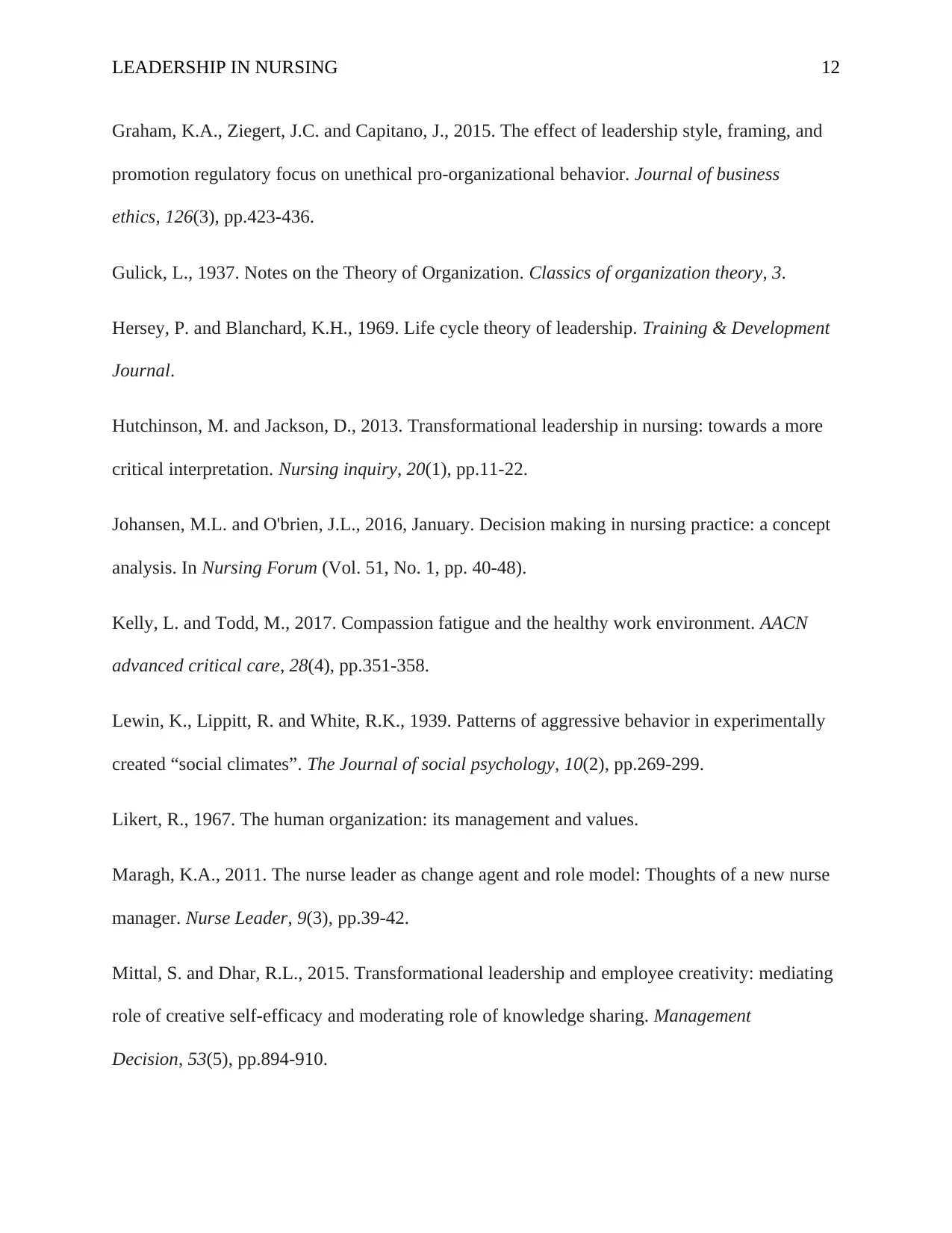
LEADERSHIP IN NURSING 12
Graham, K.A., Ziegert, J.C. and Capitano, J., 2015. The effect of leadership style, framing, and
promotion regulatory focus on unethical pro-organizational behavior. Journal of business
ethics, 126(3), pp.423-436.
Gulick, L., 1937. Notes on the Theory of Organization. Classics of organization theory, 3.
Hersey, P. and Blanchard, K.H., 1969. Life cycle theory of leadership. Training & Development
Journal.
Hutchinson, M. and Jackson, D., 2013. Transformational leadership in nursing: towards a more
critical interpretation. Nursing inquiry, 20(1), pp.11-22.
Johansen, M.L. and O'brien, J.L., 2016, January. Decision making in nursing practice: a concept
analysis. In Nursing Forum (Vol. 51, No. 1, pp. 40-48).
Kelly, L. and Todd, M., 2017. Compassion fatigue and the healthy work environment. AACN
advanced critical care, 28(4), pp.351-358.
Lewin, K., Lippitt, R. and White, R.K., 1939. Patterns of aggressive behavior in experimentally
created “social climates”. The Journal of social psychology, 10(2), pp.269-299.
Likert, R., 1967. The human organization: its management and values.
Maragh, K.A., 2011. The nurse leader as change agent and role model: Thoughts of a new nurse
manager. Nurse Leader, 9(3), pp.39-42.
Mittal, S. and Dhar, R.L., 2015. Transformational leadership and employee creativity: mediating
role of creative self-efficacy and moderating role of knowledge sharing. Management
Decision, 53(5), pp.894-910.
Graham, K.A., Ziegert, J.C. and Capitano, J., 2015. The effect of leadership style, framing, and
promotion regulatory focus on unethical pro-organizational behavior. Journal of business
ethics, 126(3), pp.423-436.
Gulick, L., 1937. Notes on the Theory of Organization. Classics of organization theory, 3.
Hersey, P. and Blanchard, K.H., 1969. Life cycle theory of leadership. Training & Development
Journal.
Hutchinson, M. and Jackson, D., 2013. Transformational leadership in nursing: towards a more
critical interpretation. Nursing inquiry, 20(1), pp.11-22.
Johansen, M.L. and O'brien, J.L., 2016, January. Decision making in nursing practice: a concept
analysis. In Nursing Forum (Vol. 51, No. 1, pp. 40-48).
Kelly, L. and Todd, M., 2017. Compassion fatigue and the healthy work environment. AACN
advanced critical care, 28(4), pp.351-358.
Lewin, K., Lippitt, R. and White, R.K., 1939. Patterns of aggressive behavior in experimentally
created “social climates”. The Journal of social psychology, 10(2), pp.269-299.
Likert, R., 1967. The human organization: its management and values.
Maragh, K.A., 2011. The nurse leader as change agent and role model: Thoughts of a new nurse
manager. Nurse Leader, 9(3), pp.39-42.
Mittal, S. and Dhar, R.L., 2015. Transformational leadership and employee creativity: mediating
role of creative self-efficacy and moderating role of knowledge sharing. Management
Decision, 53(5), pp.894-910.
⊘ This is a preview!⊘
Do you want full access?
Subscribe today to unlock all pages.

Trusted by 1+ million students worldwide
1 out of 13
Related Documents
Your All-in-One AI-Powered Toolkit for Academic Success.
+13062052269
info@desklib.com
Available 24*7 on WhatsApp / Email
![[object Object]](/_next/static/media/star-bottom.7253800d.svg)
Unlock your academic potential
Copyright © 2020–2025 A2Z Services. All Rights Reserved. Developed and managed by ZUCOL.





